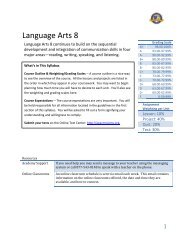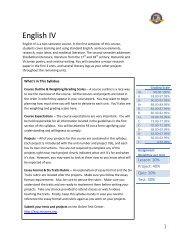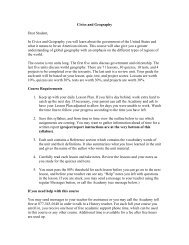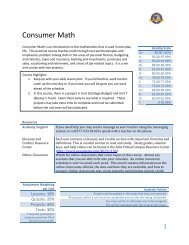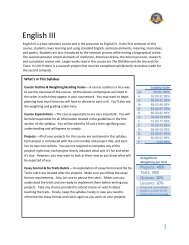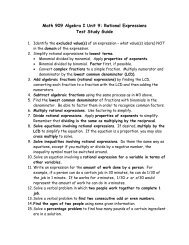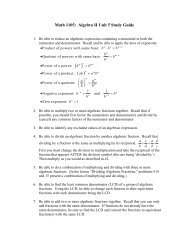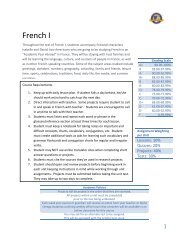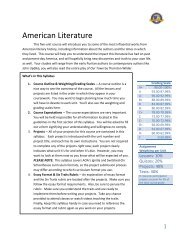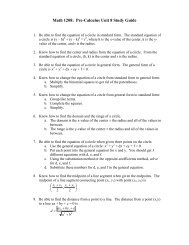Math 1201: Pre-Calculus Unit 1 Study Guide
Math 1201: Pre-Calculus Unit 1 Study Guide
Math 1201: Pre-Calculus Unit 1 Study Guide
You also want an ePaper? Increase the reach of your titles
YUMPU automatically turns print PDFs into web optimized ePapers that Google loves.
2R = x +y212. Know how to add two position vectors given their terminal points.a. Add the x-values of each position vector to find the x-coordinate of theresultant position vector.b. Add the y-values of each position vector to find the y-coordinate of theresultant position vector.c. Find the direction angle by using the tangent function (tan θ = xy ).13. Be able to find the horizontal and vertical components of a vector.a. The horizontal component = R cos θ, where R is the resultant force and θ is theangle formed by the resultant vector and the horizontal.b. The vertical component = R sin θ, where R is the resultant force and θ is theangle formed by the resultant vector and the horizontal.14. Know how to find the angles formed between two vectors and their resultant.oppositea. sin θ = hypotenuseadjacentb. cos θ = hypotenuseoppositec. tan θ = adjacent15. Be able to solve word problems about navigation.a. A knot is one nautical mile per hour, and a nautical mile is a distance of6,080.27 feet.b. The heading of an airplane is the direction in which the plane is pointed. Dueto the wind, a plane does not always go in the direction it is pointed.c. The track of a plane is its actual path.d. The course of a plane is the direction of its path.e. The air speed of a plane is its speed in still air.f. The ground speed of a plane is its speed relative to the ground or water overwhich it flies. The ground speed is the resultant of the air speed and the force ofthe wind.g. A tailwind is a wind that blows in the same general direction of the flight.h. A headwind is a wind that blows in the direction opposite that of the flight.i. Courses and bearings are generally measured clockwise from north and rangeanywhere from 0° up to 360°.
j. The air speed, the magnitude of AB, combined with the wind velocity of AC,gives AD, the ground speed and direction of flight (see diagram above).k. The angle BAD is called the drift angle (see diagram above).16. Be able to multiply a vector by a scalar.a. Multiply the magnitude by the scalar. The direction stays the same.b. Multiplying by a negative scalar reverses the direction of the vector.c. To multiply a position vector by a scalar, multiply both the x-value and the y-value by the scalar.17. Know how to subtract vectors.a. To subtract vectors, add the negative.b. A negative vector has the same magnitude but the opposite direction.c. To subtract position vectors, subtract the x-values and subtract the y-values.18. Know how to find the dot product of vectors.a. u · v = |u||v|cosθ, where θ is the angle formed by the vectors.b. u · v = u x v x + u y v y , where u x and u y are the x and y components of u and v x andv y are the x and y components of v.c. The x and y coordinates of a position vector are its x and y components. Tofind the dot product of position vectors, add the product of the x-values and theproduct of the y-values.d. The dot product of two vectors results in a scalar.



